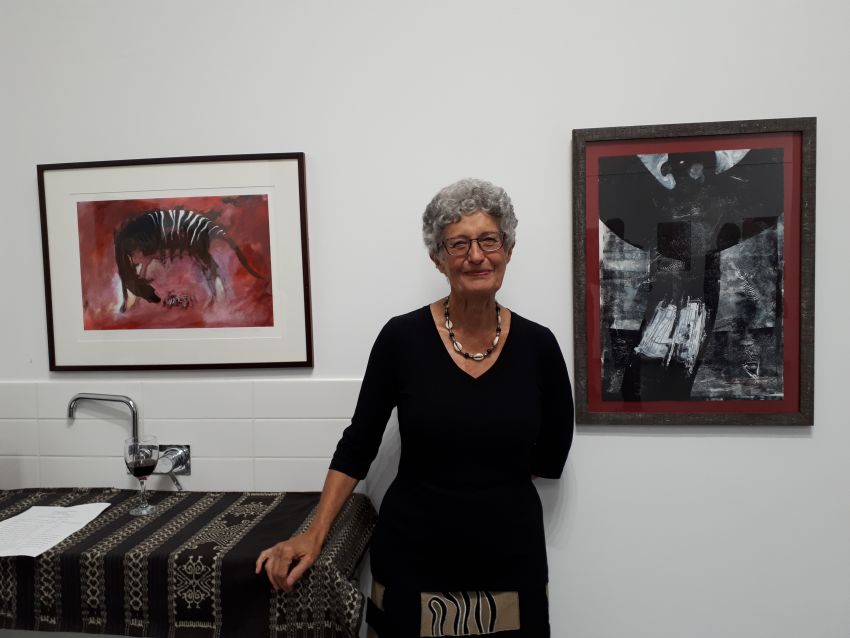
Below are the opening remarks by long-established West Australian artist, Lynne Tinley at the opening night of Earth Grief, a retrospective exhibition of her art. The exhibition was displayed at the Sustainable Housing for Artists and Creatives (SHAC) Colab2, White Gum Valley, Fremantle beginning on September 27.
Grief is a passion, an emotional force; it is the dark cloud that brings the rain.
Fifteen years ago, I heard Joanna Macy speak of owning our grief – using the passion of it to create. Last week Koral [the SHAC community convenor] sent me a link – Joan Sutherland in the Buddhist newsletter ‘Lion’s Roar’, refers to grief as "love in the face of loss".
How about that, "love in the face of loss"?!
I am a trained biologist-turned-artist and I have lived in and loved many wild places on our planet.
In 2008, I had a dream. I remember my dreams because I write them down. This dream was very vivid. I was standing on an open plain with my husband Ken by my side – and we were looking at the night sky.
All at once the stars started to fall – they fell in sheets, in sparkling masses, they rained down on outer space. I remember in my dream, my utter amazement and a feeling of great portent.
Then under a black sky the dream went on – Ken and I were now in a train on a journey with a number of other people. It was an old train. I noticed rust on the metalwork of the carriage. But it was a workable train and it was carrying us somewhere – beyond where we had been.
And then I woke up with the words of the song “It’s the end of the world as we know it”. That refrain haunted me for years after the dream. “It’s the end of the world as we know it”. Not it’s the end of the world but – it’s the end of the world as we know it.
The Thylacine – Australia’s lost marsupial wolf – came into my art long before this dream. I met the spirit of Thylacine down in the deep woodlands of Rosa Brook, south of Margaret River in the 1990s and as petroglyphs on the rocks of Murajuga, the Burrup Peninsular, in 2002.
This first Thylacine painting, represented here by a limited edition gicle’e print was when the grief broke through the love – it is a sad painting, poignant – a mother with her cubs or is it a little pile of bones. I did not intend to paint this image; it came from a deep place of love and grief.
Other works depicting living Thylacine followed; paintings that showed her hunting, sleeping, coming home to her den in the mists of dawn.
Linked to my grieving was the loss of our personal African paradise. Parque Nacional da Gorongosa in Mozambique.
During the civil war, that lasted from 1972 to the early 1990s, most of the animal life and a good deal of the human life in Gorongosa was eradicated. Ivory from elephant and hippo tusks funded the buying of ammunition for both armies; wild meat, ungulates, birds, reptiles, even primates, fed the troops and the hungry people.
We had lived in Gorongosa for six years prior to 1973 and were evacuated to Lourenco Marques, now Maputo, in the face of bombing, land mines and guerrilla attacks.
As a family, we grieved the loss of our home, the death of the herds, prides, and flocks of animals that we had known and loved, we grieved people we worked with who were shot, tortured, or who resorted to living in antbear burrows to escape detection by marauding groups of soldiers or bandits.
The feelings of betrayal and despair were such that they contributed to us leaving Africa in 1984 to come to Australia.
The grief did not disappear, it just went underground. In 2008, my vivid dream brought it again to the surface – a wider surface this time – to global climate crisis and the escalating extinction of species – to Joanna Macy’s "unravelling of the earth", to "the end of the world as we know it".
This grief took me over and my paintings were coloured by it, no matter what I was thinking at the time of painting. I became grief, it worked me and I submitted because I knew that that was how I could grow into who I truly am. Through the paintings, many more than these paintings you see here, I processed the grieving and finally I transcended it.
My paintings have changed once again. I can again paint my connection to nature in the joy of that moment, and that place, without the voice of despair murmuring in my ear. Light and laughter have come back into my work.
I feel too that there is a world-wide surge of renewed hope. I felt and saw it strongly in a recent visit to Mozambique – a ‘returning home’ visit we made to the recovering Gorongosa ecosystem and its people.
The world is becoming more conscious of its problems, especially the younger generations. Their passion, our passion, in whatever form it may be, is needed to create functional systems for Planet Earth.